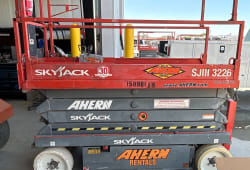Easy Crane Operation Tips for Beginners
5 Min read
)
November 25, 2023
The world of construction relies heavily on the efficient and safe operation of cranes, making it imperative for both seasoned professionals and beginners to prioritise crane safety. Easy crane operation tips specifically designed for beginners can significantly contribute to a safer work environment while ensuring the smooth execution of lifting tasks. This article delves into the fundamental aspects of crane safety and provides practical tips for beginners to enhance their crane operation skills.
How do Cranes Work?
Lifting Mechanism:
Cranes use a hoist, equipped with a hook or other lifting attachment, that is wound around a drum or wheel. This hoist can be powered by hydraulics, internal combustion, or electric motors. The motor powers the hoist, which manipulates the wire ropes or chains to lift and lower heavy loads smoothly.
Movement of Loads:
The boom of the crane allows for the movement of the load horizontally. Booms can be telescopic, articulating, or fixed, and can move via hydraulic cylinders or cables depending on the type of crane. The trolley moves along the length of the boom to place the load in the desired location.
Rotation and Mobility:
Many cranes can rotate up to 360 degrees around their vertical axis, allowing for a wide range of motion. This is typically achieved with a turntable at the base of the mast. Mobile cranes have additional mobility, often equipped with wheels or tracks that allow them to move around a site or from one site to another.
Stability and Safety:
Stability is crucial, so cranes are equipped with outriggers (extendable "legs") to distribute the load and increase stability. Modern cranes also come with load limiters and other sensors to prevent the crane from operating under conditions that might pose a risk of tipping or structural failure.
How to Operate a Crane?
Navigating the complexities of crane operation can be a challenge for beginners, but mastering basic skills and safety protocols is essential. Here, we provide targeted tips that cover the fundamental aspects of crane operation, helping new operators conduct their tasks with confidence and caution.
1. Understand Your Crane’s Manual
Every crane is unique, and knowing the specifics of the model you are operating is critical. The operator's manual is a valuable resource that provides detailed instructions on load capacities, control mechanisms, and emergency procedures. Take the time to study this manual thoroughly; familiarity with your crane's capabilities and limitations ensures safer operations and helps avoid costly mistakes.
2. Check the Weather Conditions
Weather plays a significant role in the safety and effectiveness of crane operations. High winds, precipitation, and electrical storms can all pose hazards during lifting operations. It is advisable to check the local weather conditions before beginning work and to postpone or adjust operations if adverse weather is expected. Operating a crane in poor weather conditions can compromise the safety of the load and the crew.
3. Conduct a Pre-Operation Inspection
Performing a routine check on the crane before each use is essential to ensure it is in good working condition. This inspection should include checking for mechanical issues, such as wear or damage to the crane’s wire ropes, hooks, and outriggers. Verify that all safety devices are functional, and the crane is properly balanced and stabilized according to the manufacturer's guidelines. These daily checks can prevent accidents and equipment failure.
4. Plan Your Lift
Proper planning is the key to successful crane operation. Assess the weight and dimensions of the load, ensure it is within the crane's lifting capacity, and plan the route of the lift, avoiding overhead obstacles such as power lines and buildings. Coordination with your team is crucial; make sure everyone involved understands their role and the lift plan. Detailed planning helps minimize risks and ensures a smooth operation.
5. Use Proper Communication Signals
Clear communication is vital during crane operations, especially in environments where noise or distance prevents verbal communication. Learn the standard hand signals and radio communication protocols used in crane operations. Ensure that all team members understand and use these signals during operations to maintain safety and coordination. This practice reduces the risk of accidents caused by miscommunication.
6. Stay Focused and Avoid Distractions
Operating a crane requires undivided attention. Distractions can lead to serious accidents, so it’s important to maintain focus at all times. Keep personal devices away while operating and stay alert to the environment and your crane's movements. Regular breaks can help maintain concentration over long periods, ensuring consistent vigilance.
7. Regularly Update Your Training
Crane technologies and best practices are continually evolving. Regular training updates are crucial for keeping skills sharp and knowledge current. Attending refresher courses and staying abreast of new safety regulations and technological advancements can enhance both safety and efficiency in crane operations.

Caleb Woods is an experienced content specialist and an editor at Boom & Bucket, blending his journalism background with expertise in the heavy equipment industry. He delivers engaging, informative content to help professionals stay informed and make smarter decisions in the machinery market.











